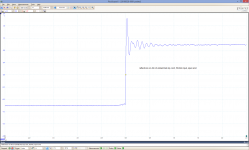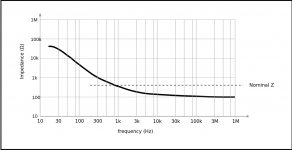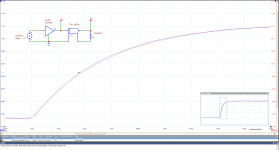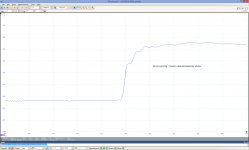Just like the case of RF and real transmission lines.
When you refer to characteristic impedance of wires, it means you are already thinking of them in terms of transmission lines.
However, things can get complicated at audio frequencies when we get down into details that are often assumed to be negligible. JN has gone into some of that before, but maybe it would be a diversion right now to do it again.
Last edited:
Now you are starting to ask the right questions. Thank you.
If you do the model I detailed, do the right tests,(or actually believe my t-line analysis) you will see that the delays reach beyond ITD delay thresholds.
The understanding of t-line.....I am not sure if I can teach you what you would need to understand on an online forum. I have understood this for 40 years now, and am quite familiar with how difficult it is to teach this to others..
I welcome the dialog..and I prefer scientific discourse, not silly replies.
Jn
Jn
Jn, I think you do not need to teach me about t-lines. During my first years in the HV high power testing lab of the Research Institute of Power Engineering in Prague, my main job was to measure and to design measuring tools like sensors and amplifiers for fast transient voltages and currents and to lead them through 80m of coax cables from the testing cell to the control and measuring room. These were fast signals from sub-microsecond rise times to relatively slow signals with industrial 50Hz frequency. Cable imperfections, even for impedance matched and terminated coax cable, were perfectly seen on fast signals.
I feel that you do not understand that cable reflections can originate only if cable is driven by a fast signal (compared to cable length). For slow signals, cable acts as a mere RLC. Reflections on the unmatched cable take long time to settle, but such reflections can only be created by fast signals. Audio system is by no means fast for the 6m of the speaker cable. It will create no reflections. It introduces its R, L, C for audio an that's all. If you want to argue, then please show your experimental results or give a link to a valid literature. That's a scientific method. Not only giving one's hypothesis.
Please stop me when I start down a wrong path. We apply an impulse from a zero source impedance to a pair of wires. The far end is randomly terminated and a (smaller) impulse bounces back, then a (still smaller) impulse bounces forward, etc. until the Sun cools or we get tired of waiting.
Chris
Audio system will never send an impulse with steep enough edges to create reflections in 20 feet of the speaker cable. The impulse would be BW limited to some 20-30 kHz and this is not enough to create reflections in a short cable.
Settling depends on the source impedance, the line impedance, and the load impedance. I prefer working with actual amps, cables and speakers. Course, that's just me.
Jn
As to your question, when the load and line match, that is optimal.
These are very basics you can find in any textbook. But first, reflections must be created. Slow signal with wavelengths 1000 times longer than cable length is does not create any reflections in the cable.
Last edited:
And after this point, I'm in over my head. I do realize that transmission lines only exist at multiples of wavelength, and that infinite length transmission lines approach iterated lumped LC. It's the non-idealized cases like audio that are (probably forever) beyond me.When you refer to characteristic impedance of wires, it means you are already thinking of them in terms of transmission lines.
Much thanks,
Chris
Audio system will never send an impulse with steep enough edges to create reflections in 20 feet of the speaker cable. The impulse would be BW limited to some 20-30 kHz and this is not enough to create reflections in a short cable.
But, would it be more complete to say that reflections will always occur, but are not significant (whatever that means) in ordinary home audio systems and ordinary human ears?
If so, then the answer must be resolved with numbers. Please correct any misconceptions on my part.
Much thanks, as always,
Chris
Jakob is usually very precise in his explanations which often means attempting to cover all angles and if possible statistical probabilities of each 🙂 This can seem like obfuscation but I think it's more pendentry 😉, which I believe most of us can relate to to a degree 🙄Some people seem to have an unusually sensitive obfuscation detector. Can make it easier than otherwise to result in some false positives. Might be worth considering dialing back the sensitivity a little in Jakob2's case. Some useful knowledge and insights might benefit everyone here, not just you.
But, would it be more complete to say that reflections will always occur, but are not significant (whatever that means) in ordinary home audio systems and ordinary human ears?
If so, then the answer must be resolved with numbers. Please correct any misconceptions on my part.
Much thanks, as always,
Chris
I do not think so. Will DC have any reflections? And please let's not speculate about DC turn-on, which may have infinite BW and infinitely short rising edge. I speak about BW limited system as audio is and I am saying there are no reflections if signal components at the cable input have all wavelengths in orders longer than is the cable length. That's why I am posting my experiment measurements, BW limited audio system is driven by a perfect step at amp input, but the cable only sees a BW limited step and no reflections are created. Different time delays between input and output cable signal do exist during the rising edge, but they are in tens of ns up to 100ns range, which is unimportant for the audio system, which will mask this effect.
Attachments
I have understood this for 40 years now, and... Jn
Please don't start like JC 😉
I am not a crazy goofball audio cultist who espouses silly theories that defy physics. I am a person who is applying serious physics and e/m understanding to the problem at hand.
Jn
And for this I, and many more I'm sure, thank You!
//
Last edited:
Some people seem to have an unusually sensitive obfuscation detector. Can make it easier than otherwise to result in some false positives. Might be worth considering dialing back the sensitivity a little in Jakob2's case. Some useful knowledge and insights might benefit everyone here, not just you.
I welcome the dialog..and I prefer scientific discourse, not silly replies.
It's very politely said.
t's like proposing to change the air filter of your VW Beetle to win the 500 miles of Indianapolis.Twisted pair cables are generally something like 100R characteristic impedance. I find 100R termination resistor at each end of the speaker cables makes for cleaner sound, same with 75R for coax used as speaker cables. Just sayin'.
Thank you very much for your comments and for creating the graphic. I think I understand your point better now. It raises another question: how sensitive is the audio system to pathological speaker cables? (A good friend has the MIT cables with the large, heavy, sealed lumps on both ends - mandatory for his Spectral amplifier - and they're maybe 4 meters).BW limited audio system is driven by a perfect step at amp input, but the cable only sees a BW limited step and no reflections are created. Different time delays between input and output cable signal do exist during the rising edge, but they are in tens of ns up to 100ns range, which is unimportant for the audio system, which will mask this effect.
But this is way off base and an unproductive direction. Your discussion with JN is much more interesting.
Much thanks, as always,
Chris
Small remark - Jn mostly speaks and argue about ITD .. I assume that no one uses completely different speaker cables for both audio channels, so hearing can detect such an ITD...
Reflections on an unmatched zip cord, 4m. Zgen = 50ohm, cable output open, measured at output. This is something that audio signal from an audio system will never create. But yes, as JN mentioned, settling time is in microseconds to damp the reflections.

I think he argues that some tens or a hundred of ns is a significant portion of shortest detectable ITD, which is about 2us. He cares about freqeuncy dependent time delays due to complex speaker load, that creates a divider with the cable. Then the effect might be in tens of ns. OK, but I would request a test proof then that such an interchannel change might be audible. IMO, no.

Small remark - Jn mostly speaks and argue about ITD .. I assume that no one uses completely different speaker cables for both audio channels, so hearing can detect such an ITD...
I think he argues that some tens or a hundred of ns is a significant portion of shortest detectable ITD, which is about 2us. He cares about freqeuncy dependent time delays due to complex speaker load, that creates a divider with the cable. Then the effect might be in tens of ns. OK, but I would request a test proof then that such an interchannel change might be audible. IMO, no.
Yes, transition lasts about 0,5 -1uS , but damped ringing frequency is about 10MHz.. No one transducer can reproduce this as sound, no one ear can hear it..
4m zip cord driven from Rg=50ohm and terminated with 50ohm. We can see much faster settling with no "ringing", still there is a reflection because terminating impedances are not match to cable Zw. However, again, audio signal will never create this phenomenon.
Attachments
Could-you make the same measurement, in a situation closer to the real one: across one of your amp (to get a real low source impedance and limited slew rate), and with, say, a 6 Ohm load ?Reflections on an unmatched zip cord, 4m. Zgen = 50ohm, cable output open, measured at output. This is something that audio signal from an audio system will never create. But yes, as JN mentioned, settling time is in microseconds to damp the reflections.
But, well, I do not want you to waste your time in useless measures of which we know the result: 0, nothing, nada.
Especially if we compare with the acoustic signal from a tweeter that would replace the load ;-)
Last edited:
Could-you make the same measurement, in a situation closer to the real one: across one of your amp (to get a real low source impedance and limited slew rate), and with, say, a 6 Ohm load ?
It was shown yesterday, and also today in this post
John Curl's Blowtorch preamplifier part III
and I am hoping that at least some members would realize what it means. If not, then any explanation is hopeless.
T, It's a fifty cent expenditure that IME improves sound.It's like proposing to change the air filter of your VW Beetle to win the 500 miles of Indianapolis.
Did you think through all the implications of what my suggestion does on typical systems ?.
Dan.
I am really struggling to understand how a cable can cause problems at AUDIO frequencies. Seriously.
If you want to go pumping ns rise time signals down your speaker cable then yes, you will see reflections, etc, but not at audio.
If you want to go pumping ns rise time signals down your speaker cable then yes, you will see reflections, etc, but not at audio.
I am really struggling to understand how a cable can cause problems at AUDIO frequencies. Seriously.
If you want to go pumping ns rise time signals down your speaker cable then yes, you will see reflections, etc, but not at audio.
Many people here do not understand this simple fact. Maybe for the reason they have no educational and experimental background in this field. Jan started a good thread
https://www.diyaudio.com/forums/the-lounge/338453-ignorance-resource-new-post.html
I think that ignorance is the main reason why threads like this one (JC BT part XY) may exist. Every attempt for explanations is completely useless, then. Wasting time.
<snip> I seem to remember your earlier definition of timbre was very wishy-washy - care to represent it here?
You can´t blame scottjoplin for that as one of the definitions of "timbre" is a negative one by exclusion, see for example the ANSI (1994) version, which is based on Helmholtz´s usage of the term in the 19th century:
"Timbre. That attribute of auditory sensation which enables a listener to judge that two nonidentical sounds, similarly presented and having the same loudness and pitch, are dissimilar."
The two nonidentical sounds should have the same duration.
Others strongly criticize this, see for example Bregman (already in 1990) :
"This is, of course, no definition at all. … The problem with timbre is that it is the name for an ill-defined wastebasket category."
Wrt our hearing sense, "timbre" is a multidimensional perceptual attribute, but it is difficult to find a precise (but short) definition that covers all aspects.
Last edited:
4m zip cord driven from Rg=50ohm and terminated with 50ohm. We can see much faster settling with no "ringing", still there is a reflection because terminating impedances are not match to cable Zw.
Not so fast, expect digital source and wide bandwidth preamp and power amp to deliver significant ultrasonic/RF junk, just right for exciting ringing.However, again, audio signal will never create this phenomenon.
Nominal Impedance

Dan.
- Status
- Not open for further replies.
- Home
- Member Areas
- The Lounge
- John Curl's Blowtorch preamplifier part III

